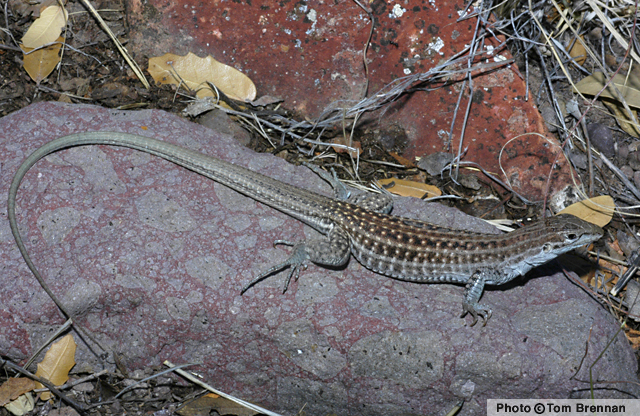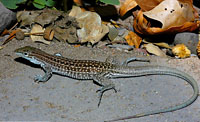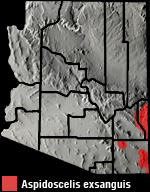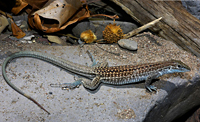Online Field Guide to The Reptiles and Amphibians of Arizona



Greenlee County, AZ
 Greenlee Co., AZ |
| CHIHUAHUAN SPOTTED WHIPTAIL Aspidoscelis exsanguis |
|
|
DESCRIPTION: A medium-sized (up to 100 mm or 3.9″ from snout to vent), slim, gray-brown to orange-brown lizard with a long, thin tail, and a slim, pointed snout. The body is marked with six (rarely seven) muted, light gray-brown, stripes and numerous light spots. The spots become a vibrant, bright yellow color on the hind limbs and lower back. The tail is olive-gray. The underside is plain and pale. Young animals lack spots and have more distinct stripes. The scales on the body are small and granular. The scales on the tail are large, keeled, and rectangular. The scales on the belly are large, smooth, and rectangular. The scales on top of the head are large, smooth, and plate-like. This lizard is distinguished from other whiptails in Arizona by its indistinct stripes, relatively numerous spots, and bright yellow spots on the hind limbs and lower back. HABITAT: Primarily an inhabitant of Madrean Evergreen Woodland and Semidesert Grassland communities but this lizard also enters the lower reaches of Petran Montane Conifer Forest. It is usually encountered in relatively moist areas such as canyon bottoms, drainages, and riparian corridors. BEHAVIOR: This is an alert, diurnal, fast-moving ground-dweller. It is often encountered in the morning foraging or basking in the sun. It hibernates during the cold months of winter and late fall. DIET: It actively forages by rooting around in organic matter under bushes and digging in the soil around the bases of rocks, and other surface debris. Prey consists of termites, beetles, other insects, spiders, and scorpions. REPRODUCTION: All Chihuahuan Spotted Whiptails are female (parthenogenetic). Eggs are unfertilized and hatchlings are clones of the mother. Clutches of 1 to 6 eggs are laid in summer. By Thomas C. Brennan Brennan, T. C., & A. T. Holycross. 2006. A Field Guide to Amphibians and Reptiles in Arizona. Arizona Game and Fish Department. Phoenix, AZ Degenhardt, W. G., Painter, C. W., and Price, A. H.. 1996. Amphibians and Reptiles of New Mexico. University of New Mexico Press. Albuquerque. Stebbins, R.C. 2003. A Field Guide to Western Reptiles and Amphibians, Third Edition. Houghton Mifflin Company, Boston, MA |
 |
Visit Partners in Amphibian and Reptile Conservation:


HOME
Copyright © 2023, Arizona Game and Fish Department. All rights reserved.
If you make use of the textual contents of this site in reports, publications, etc. please cite and credit the author(s) and photographer(s). All photos on this website are copyrighted. However, those found in the species account section may be used for any noncommercial scientific, educational, or conservation purposes provided that photographs are not altered and continue to bear the copyright symbol and name of the photographer. Please contact the photographer regarding commercial use of copyrighted photographs.










